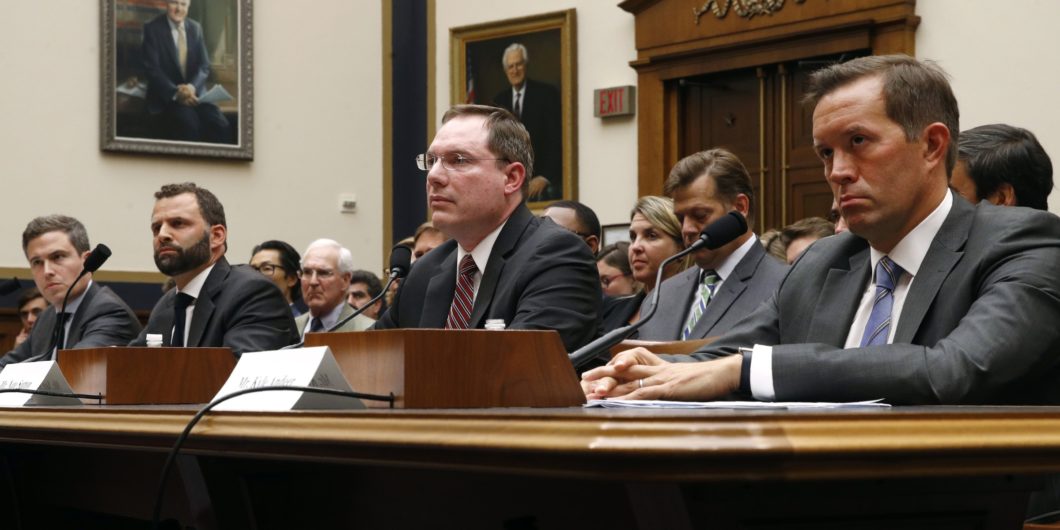The recent inquiry on the invocation of the Emergencies Act shows the danger it poses to the rule of law.
The Rotten Roots of Neo-Brandeisian Antitrust
Neo-Brandeisian antitrust puts old wine into old wineskins. It repeats the fundamental mistakes of Louis Brandeis’s vision of antitrust in the early 20th century. Brandeis believed that the judiciary could balance a variety of social goods to create a better sort of competition than the market. He thus made three mistakes simultaneously. First, he substituted his own view of competition for that defined by the market. Second, once he had surrendered a focus on price signals provided by the market like any other centralized decisionmaker, he lacked the information to make better decisions. Finally, he failed to recognize that the judiciary was particularly unsuited to determine how to balance other values with those of market competition.
Because Neo-Brandeisians are making the same errors as their hero—errors that Kristian Stout well catalogues in his lead essay, it is useful to understand the source of their mistakes in the antitrust analysis of Brandeis himself and the contrast it makes with the analysis of William Howard Taft. The competing views of these two titans of early antitrust has set the stage for all the debates that have come after.
Even their biographies underscore that the skirmish over antitrust was then, as it is now, part of the larger battle of the market versus the state. Taft was a Republican on the wing of the party committed to laissez-faire. Brandeis was a quintessential progressive, committed to remaking the economy though government. There is a direct political connection between them as well. Brandeis was appointed to the Supreme Court in 1916 only because Woodrow Wilson defeated Taft for reelection as President in 1912.
Before he became President and later Chief Justice of the United States, Taft was a judge on the Sixth Circuit Courts of Appeals. There he rendered a decision, Addyston Pipe, which remains a staple of antitrust textbooks more 120 years after it was issued. Its staying power as an opinion of a lower court testifies to the remarkable power and lucidity of its reasoning. Here Taft showed that antitrust law requires only the relatively modest judicial role of perfecting market competition and that the judiciary can best accomplish this goal by following the distillation of the common law wisdom of the ages.
The case was prompted by a cartel of pipe manufacturers. They had fixed prices and so were sued by the United States as having created a “restraint of trade” under the Sherman Act. They defended their agreement on the grounds that the price was designed to prevent ruinous competition that would put many out of business and that the prices they set were, in any event, “reasonable.”
Taft rejected both defenses. He looked to the common law to understand the meaning of the restraint of trade. Agreements by competitors on price should be upheld only if they were “ancillary” to something productive like a non-compete agreement which accompanied a sale of a business. For instance, the sale of the business to a more productive owner well might not happen if the former owner stayed around to compete and capitalize on this past good will. Thus, it should be permitted. But protecting the profits of the producers or the jobs of their employees did not advance the productivity of the economy and so did not constitute a defense to interfering with the market process of arriving at a price.
Taft also summarily rejected the argument that price fixing should be upheld if the prices were reasonable. His key insight here is that the price system is also a process for providing information. It is the market that decides what is the accurate price. Judges no more than any other government actor have a mechanism to figure it out for themselves. Trying to do so would set them, in Taft’s famous words, on “a sea of doubt.” For Taft, antitrust is just a legal regime for defense of the natural movements of the market, and the judicial role is a limited one.
In Chicago Board of Trade v. United States, Brandeis took the opposite approach from Taft. He failed to define antitrust as simply protecting market competition and never showed that the restraints competitors imposed were necessary or even related to enhanced productivity or a more efficient equilibrium. In that case, the Chicago Board of Trade had set up a market for “to arrive grain.” “To arrive grain” was grain that was being shipped and could be sold in transit. It was to be distinguished from spot sales—that is sales of grain that had already arrived in Chicago. The Board of Trade, which was composed of grain merchants, also added a “call rule” condition to the market they made. That rule prohibited the members of the Board from making an offer to buy “to arrive” grain after the daily call at any price other than that set at end of the trading sessions. Thus, these merchants fixed prices until the Chicago Board opened again the next day. It was the call rule that the government therefore challenged.
Brandeis does not define competition by the market but by some ideal structure determined by the judge. Here is what he says:
The true test of legality is whether the restraint imposed is such as merely regulates, and perhaps thereby promotes competition, or whether it is such as may suppress or even destroy competition. To determine that question, the court must ordinarily consider the facts peculiar to the business to which the restraint is applied, its condition before and after the restraint was imposed, the nature of the restraint, and its effect, actual or probable. The history of the restraint, the evil believed to exist, the reason for adopting the particular remedy, the purpose or end sought to be attained, are all relevant facts.
Rather than a clearly focused test—does this restraint among competitors advance productivity or otherwise protect the market— Brandeis allows the judge to assess whether some undefined evil is prevented by the restraint, and make that decision by looking at facts peculiar to different sectors of the economy.
And he applied his test in way that showed his confidence in the Supreme Court’s ability to discern answers to these open-ended questions. First, he noted the limited hours of the restriction. But that limitation does not advance productivity and it impedes price movement. News of a drought could affect prices overnight during the period when trading in “to arrive grain” was restricted. Second, he noted that the market spot grain was unaffected by the rule, allowing such grain to be purchased without regard to the call rule. But the existence of a related market does not justify the restriction in the market in the case. Indeed, it puts the judge on a sea of a doubt against which Taft warned, because we cannot be sure the overall price for grain will be the same during those off hours as it would be without the restriction on “to arrive” grain.
Then he listed seven other factors that justified the restrictions. Some of them had nothing to do with market efficiency. For instance, he noted that the restraint helps “country merchants” (i.e. small merchants), presumably because they would have more trouble bidding in the off-hours. But there is in fact a tension with keeping small and less efficient actors in business and promoting market competition. The market naturally penalizes the less efficient actors.
Brandeis also suggested that restrictions on hours helped make a thick market when it was open, but he did not begin to show that this restriction was needed to accomplish this goal. If merchants facilitated a market during certain hours, the greater numbers of dealers bidding at that period would narrow the difference between bid and ask prices and encourage others to participate without the call rule. In other words, the market would spontaneously become thick, insofar as the advantages of that thickness outweighed the advantages in trading in the off hours.
In his final act of judicial hubris, Brandeis did not even remand the matter to the district court to try to determine the economic effects of the many facts his opinion amassed. (The opinion indeed reads like one of the famous “Brandeis briefs”—a lump of facts with a bare minimum of analysis.) Instead he not only reversed summary judgment for the government, but also dismissed the suit altogether.
These cases both concerned agreements among competitors and it was Taft, the orthodox free marketeer, who ruled against business, showing once more that in antitrust as elsewhere, being pro-market is different from being pro-business. But even though the context was different from the monopoly cases that neo-Brandeisians want the government to bring, the contrast in the cases shows that the mistakes of neo-Brandeisians exactly track those of the founder of their school.
As Stout notes, the neo-Brandeisians tend to frame their arguments in one of two ways:
First, there is some ideal number of competitors in a given market that must exist before a market is competitive and, second, there are noncompetition goals that enforcers and judges should consider when looking at antitrust cases (such as labor rights, political corruption, and income inequality).
But their first argument runs up against the limits of judicial or indeed bureaucratic knowledge. To determine the ideal the number of competitors is to set the justices on the “sea of doubt” that Taft so well described. Focusing on a number requires ignoring the many other considerations that may make a market efficient. For instance, it fails to take account that because of network effects (the notion that certain services become more valuable to consumers the more other consumers participate in a network), a single firm like Facebook may be the efficient provider.
Because of the many factors that make for optimal economic welfare, the market, not the judiciary, is best at determining the optimal number of competitors. To be sure, antitrust law should assure that competitors with market power like Facebook are acting in business justified ways. But business justification is best measured, as Taft again showed, by the practices businesses traditionally employed, not by judicial determinations of what the practices should be. Second, when judges consider noncompetition goals as Brandeis did in Chicago Trade, they slight market efficiency and make antitrust an anti-market rather than pro-market force. Yet the Neo-Brandeisan antitrust advocates want competition law to serve a myriad of values other than market efficiency. According to Neo-Brandeisians, it should temper our growing inequality. It should prevent companies from abusing our privacy. It should make sure that companies are not big enough to affect political outcomes.
Many of these values are those which economist populists accuse Silicon Valley companies of trampling. According to this critique, these companies create the one percent and mint millionaires. They sell our personal data. They become vectors of political influence either through being manipulated by outside influences like Russia or by manipulating our government though an army of lobbyists in Washington.
But antitrust law is not well designed to serve these various objectives. Even if there is too much inequality, economists have shown that the most efficient way to reduce it is through progressive taxation, not through regulation, including antitrust. The way to protect privacy, if that is an independent value, is through laws on privacy, because competition will not deliver the level of privacy that society decides is in our best interest. Lobbyists will seek political influence so long as government is as big as it is. The way to reduce lobbying is to reduce the state’s power. Moreover, judges have no metric for determining the proper tradeoff between market efficiency and other values. For instance, the innovation of a dynamic market may increase inequality at least for a period. It is just not possible to advance both through a legal case. But importing these values into competition law does provide substantial discretion to antitrust decision makers. It thus places an activist and unaccountable judiciary at the commanding heights of the economy, subordinating the market to the state.



